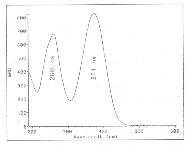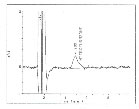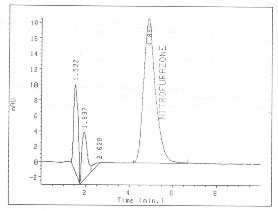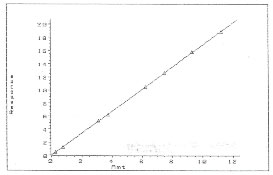1. General Discussion
1.1 Background
1.1.1 History of procedure
This evaluation was
undertaken because OSHA recently received samples requesting the
analysis of nitrofurazone. The samples had been collected on glass
fiber filters. This describes the method developed for the sampling
and analysis of nitrofurazone.
1.1.2 Toxic effects (This section is for
information only and should not be taken as the basis of OSHA
policy.)
Oral toxicity tests have been done on rats. The
results of these tests showed an increased incidence of benign mammary
tumors, which was insufficient to evaluate the carcinogenicity of
nitrofurazone. (Ref. 5.1) The oral LD50s for mice and rats
are 249 mg/kg and 590 mg/kg respectively. (Ref. 5.3)
1.1.3
Potential workplace exposure
Nitrofurazone is used as an
antibacterial agent in human medicines and veterinary medicine. (Ref.
5.1) There was no information available on the number of workers
exposed to nitrofurazone each year.
1.1.4 Physical properties
(Ref. 5.1 to 5.3)
CAS number: 59-87-0
IMIS number:
N905
Molecular weight: 198.16
Molecular formula:
C6H6N4O4
Melting
point: 236-240°C decomposes
Solubility: Soluble in
dimethylformamide, polyethylene glycol; slightly soluble in propylene
glycol, acetone; very slightly soluble in water; almost insoluble in
chloroform, benzene
| Chemical name: |
5-nitro-2-furaldehyde
semicarbazone
|
| Synonyms: |
Aldomycin; Alfucin; Amifur; Babrocid;
Becafurazone; Biofuracina; Biofurea; Chemofuran; Chixin;
Cocafurin; Coxistat; Dermofural; Dynazone; Eldezol F-6; Fedacin;
Flavazone; Fracine; Furacilin; Furacillin; Furacin; Furacin-E;
Furacine; Furacinetten; Furacine-HC; Furacoccid; Furacort;
Furacycline; Furaldon; Furalone; Furametral; Furan-ofteno;
Furaplast; Furaseptyl; Furaskin; Furaziline; Furazin; Furazina;
Furazol W; Furazone; Furesol; Furfurin; Furosem; Fuvacillin;
Hemofuran; Ibiofural; Mammex; Mastofuran; Monofurazan; NSC-2100;
Otofural; Otofuran; Rivafurazon; Rivopon-S; Sanfuran;
Spray-Dermis; Sprayforal; Vabrocid; Vadrocid;
Yatrocin
|
| Description: |
A microcrystalline, lemon-yellow, odorless
solid; darkens on prolonged exposure to light
|
| UV Scan: |

Figure 1
UV Scan of Nitrofurazone in
Mobile
Phase
|
| Structure: |

| |
1.2 Limit defining
parameters
The detection limit of the analytical procedure
is 1.25 ng per injection. This is the amount of analyte which will
give a peak whose height is approximately five times the baseline
noise
|

Figure
2
Detection Limit Chromotogram
of Nitrofurazone at
374mn | 2.
Sampling Procedure
2.1 Apparatus
2.1.1 A personal sampling pump that
can be calibrated to within ±5% of the recommended flow rate with the
sampling device in line.
2.1.2 Glass fiber filters, 37-mm
diameter, Gelman Type A or equivalent.
2.1.3 Cassette filter
holders for 37-mm filters, Millipore M000037A0 or equivalent.
2.2 Reagents
No sampling
reagents are required.
2.3 Sampling technique
2.3.1 Immediately before sampling,
remove the plastic plugs from the cassette.
2.3.2 Wrap each
cassette with foil to protect it from light exposure.
2.3.3
Attach the cassette to the sampling pump with flexible
tubing.
2.3.4 Attach the cassette vertically in the employee's
breathing zone in such a manner that it does not impede work
performance.
2.3.5 After sampling for the appropriate time,
remove the cassette and seal with plastic plugs.
2.3.6 Wrap
each sample end-to-end with an OSHA seal (Form 21).
2.3.7
Record the air volume for each sample, and list any possible
interferences.
2.3.8 Submit at least one blank for each set of
samples. Handle the blank in the same manner as the samples, except no
air is drawn through it.
2.3.9 Submit bulk samples for analysis
in a separate container. Do not ship with air samples.
2.4 Extraction
efficiency
Twenty-four glass fiber filters were each liquid
spiked with 10 µL of a 2.34416 mg/mL solution of nitrofurazone.
These samples were allowed to dry in the dark at ambient
temperature in a drawer overnight. Six of these samples were each
desorbed with 5.0 mL of DMF in amber or foil covered vials, shaken
for 30 min and then analyzed as in Section 3. The results are
listed in Table 2.4.
2.5 Retention
efficiency
The remaining eighteen spiked glass fiber
filters from Section 2.4 were placed on a humid air generator and
240 L of humid air (~86% relative humidity) were drawn through
each filter at 1 L/min. Six of the filters were each desorbed with
5.0 mL of DMF in amber or foil covered vials, shaken for 30 min
and then analyzed as in Section 3. The results are listed in Table
2.5. The remaining samples were stored 6 in a drawer at ambient
temperature and 6 in a refrigerator for use in a storage study
below. |
Table
2.4
Extraction Efficiency
|
amount
spiked,
µg |
amount
found,
µg |
recovered
% |
|
| 23.442 |
23.393 |
99.8 |
| 23.442 |
23.355 |
99.6 |
| 23.442 |
23.662 |
100.9 |
| 23.442 |
21.510 |
91.8 |
| 23.442 |
23.777 |
101.4 |
| 23.442 |
23.510 |
100.3 |
|
 |
99.0 |
|
Table
2.5
Extraction Efficiency
|
amount
spiked, µg |
amount
found,
µg |
recovered
% |
|
| 23.442 |
23.262 |
99.2 |
| 23.442 |
23.606 |
100.7 |
| 23.442 |
19.928 |
85.0 |
| 23.442 |
23.364 |
99.7 |
| 23.442 |
23.359 |
99.6 |
| 23.442 |
23.510 |
100.3 |
|
 |
97.4 |
| | 2.6 Sample storage
After 5 days of storage, 6
samples were each desorbed with 5.0 mL of DMF in amber of foiled covered
vials, shaken for 30 min and then analyzed as in Section 3. Three of the
samples were from ambient storage and the other three were from the
refrigerated storage samples. The remaining samples were analyzed after
8 days of storage. The results are given in Tables 2.6.1 and
2.6.2.
Table
2.6.1
Ambient Storage
|
amount
spiked,
µg |
amount
found,
µg |
recovered
% |
|
| 23.442 |
23.064 |
98.4 |
| 23.442 |
23.093 |
98.5 |
| 23.442 |
23.660 |
100.9 |
| 23.442 |
23.456 |
98.5 |
| 23.442 |
23.049 |
98.3 |
| 23.442 |
23.362 |
99.7 |
|
 of 5 of 5 |
99.3 |
|
 of 8 of 8 |
97.9 |
| |
Table
2.6.2
Refrigerated Storage
|
amount
spiked,
µg |
amount
found,
µg |
recovered
% |
|
| 23.442 |
23.407 |
99.8 |
| 23.442 |
23.294 |
99.4 |
| 23.442 |
23.665 |
101.0 |
| 23.442 |
22.516 |
96.0 |
| 23.442 |
23.430 |
99.9 |
| 23.442 |
22.783 |
97.2 |
|
 of 5 of 5 |
100.1 |
|
 of 8 of 8 |
97.7 |
| |
2.7 Recommended air volume and sampling rate
2.7.1 The recommended air volume is
240 L.
2.7.2 The recommended flow rate is 1.0 L/min.
2.8 Interferences (sampling)
It
is not known if any compounds will interfere with the collection of
nitrofurazone. Any suspected interferences should be reported to the
laboratory.
2.9 Safety precautions (sampling)
2.9.1 Attach the sampling equipment in
such a manner that it will not interfere with work performance or
employee safety.
2.9.2 Follow all safety practices that apply
to the work area being sampled. 3. Analytical Procedure
3.1 Apparatus
3.1.1 A balance capable of weighing to
the nearest tenth of a milligram. A Mettler HL52 balance was used in
this evaluation.
3.1.2 A mechanical shaker.
3.1.3 An
HPLC equipped with a UV detector. A Hewlett Packard (HP) 1090M
equipped with an autosampler and diode array detector was used in this
evaluation.
3.1.4 An HPLC column capable of separating
nitrofurazone from any interferences. A 100 mm × 2.1 mm i.d. Hypersil
ODS (5 µm) liquid chromatography column was used in this
evaluation.
3.1.5 An electronic integrator, or some other
suitable means for measuring detector response. The Hewlett-Packard
1090M Data System was used in this evaluation.
3.1.6 Volumetric
flasks and pipets.
3.1.7 Vials, 2-mL and 20-mL. (amber or foil
covered vials) 3.2
Reagents
3.2.1 Dimethylformamide, HPLC grade,
obtained from Burdick and Jackson was used in this
evaluation.
3.2.2 Nitrofurazone, reagent grade, obtained from
Aldrich (98% purity) was used in this evaluation.
3.2.3 Water,
HPLC grade, Milli-Q filtered water, Millipore Inc.
3.2.4
Acetonitrile, HPLC grade, obtained from Burdick and Jackson was used
in this evaluation. 3.3 Standard
preparation
Prepare nitrofurazone stock standards in subdued
light by weighing 10 to 15 mg of nitrofurazone. Transfer the
nitrofurazone to separate 10-mL volumetric flasks, and add DMF to the
mark. Make working range standards of 2.0 to 185 µg/mL by diluting the
stock standards with DMF. Store stock and diluted standards in amber
bottles in a freezer.
3.4 Sample preparation
3.4.1 Transfer the glass fiber filter
to a 20-mL vial. (amber or foil wrapped vial)
3.4.2 Add 5.0 mL
of DMF to each vial and seal with a Teflon-lined cap.
3.4.3
Shake the vials for 30 minutes on a mechanical shaker.
3.4.4 If
necessary, transfer the samples to 2-mL amber vials for use on an HP
autosampler. 3.5
Analysis
3.5.1 Instrument
conditions
| Column: |
100 mm × 2.1
mm i.d. Hypersil ODS (5 µm) |
| Mobile
phase: |
10%
acetonitrile 90% water |
| Flow rate: |
0.25
mL/min |
| Wavelength: |
260 and 374
nm |
| Retention
time: |
4.7 min |
| Injection
volume: |
5.0
µL |
3.5.2 Chromatogram:
3.6 Interferences
(analytical)
3.6.1 Any collected compound having a similar
retention time to that of the analyte is a potential
interference.
3.6.2 HPLC conditions may generally be
varied to circumvent interferences.
3.6.3 Retention time
on a single column is not proof of chemical identity. Analysis
on an alternate HPLC column and confirmation by mass
spectrometry are additional means of
identification.
|

Figure
3.
Chromatogram of Nitrofurazone at 374
nm | 3.7
Calculations
3.7.1 Construct a calibration curve by
plotting detector response versus concentration (µg/mL) of
nitrofurazone.
3.7.2 Determine the µg/mL of nitrofurazone
in each sample and blank from the calibration
curve.
3.7.3 Blank correct each sample by subtracting the
µg/mL found in the blank from the µg/mL found in the
sample.
3.7.4 Determine the air concentration by using
the following formula.
|

Figure 4.
Calibration
curve | 3.8
Safety precautions (analytical)
3.8.1 Avoid skin contact and air
exposure to nitrofurazone.
3.8.2 Avoid skin contact with all
solvents.
3.8.3 Wear safety glasses at all times.
4. Recommendation for
Further Study
4.1 This method should be fully
validated.
4.2 Additional information and studies should be
obtained on the light sensitivity of nitrofurazone to ascertain the
extent of protection necessary. Preliminary studies showed that the
response of a nitrofurazone standard in solution would decrease with the
duration and intensity of light exposure. Also, it was noted that the
recovery of nitrofurazone from spiked filters exposed to light was lower
than spiked filters protected from light. 5. References
5.1 IRAC Monographs
on the Evaluation of the Carcinogenic Risk of Chemicals to
Humans; International Agency for Research on Cancer: Lyon, 1974;
Vol. 7, pp 171-180.
5.2 Merck Index,
11th ed.; Windholz, Martha Ed.; Merck: Rahway, NJ, 1983; p
1044.
5.3 Registry of Toxic Effects of
Chemical Substances 1985-86 Edition; DHHS(NIOSH) Publication No.
87-114, U.S. Department of Health and Human Services: Cincinnati, OH,
1987; pp 2460-2461
|

